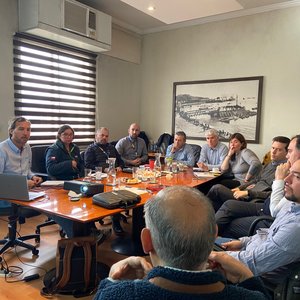Baltic herring new fish feed
At the end of October, the European Council adopted a Baltic Sea Strategy. That the EU now has a strategy for the region in place is one of the Swedish Presidency's greatest successes. The aim of the strategy is to increase growth in the region and create a cleaner Baltic Sea. Orian Bondestam at the Finnish Ministry for Agriculture and Forestry talks about new feed for cultivated fish, one of the Baltic Sea Strategy's flagship projects for a better marine environment.
Photo: Privat
Orian Bondestam
The eutrophication of the Baltic Sea is a major problem. Reducing excessive inflow of nutrients into the sea is one of the fifteen priorities in the Baltic Sea Strategy action plan.
Orian Bondestam, consultative civil servant at the Finnish Ministry for Agriculture and Forestry, why is it important to reduce eutrophication in the Baltic Sea?
“The Baltic Sea is particularly vulnerable as it is an inland sea. The long cycle of seawater exchange contribute to the surplus of nutritive salts in the Baltic Sea. Nutritive salts are the cause of a large number of environmental problems, from algal blooms to anoxic sea beds. Anyone who has spent time on the seaside can testify to the problem of eutrophication. Eutrophication also affects fish stocks in the Baltic Sea. It is more difficult for fish to breed."
How can measures in the Baltic Sea Strategy contribute to reduced eutrophication?
“One of the projects in the Baltic Sea Strategy concerns the development of sustainable aquaculture. Aquaculture is one of the industries affecting the marine environment. This effect can be minimised in different ways, for example by placing fish farms in areas with good water circulation.
Eutrophication can also be reduced by developing feeding technology for fish farms. Fish feed consists of fish meal which today is produced mostly from Atlantic or North Sea fish. A small proportion of the fish feed given to the Baltic Sea farms is not consumed by the cultivated fish but ends up in the sea instead, contributing to eutrophication. In practice, this means that we are getting an inflow of nutrients into the Baltic Sea.
If we instead would use Baltic Sea fish only, for example herring or sprats, as basis for the production of fish feed, then nutrients would circulate. We get a closed circuit of nutrients and there is no new inflow of nutritive salts into the Baltic Sea via the release of fish feed.
One of the Baltic Sea's 80 flag ship projects addresses the development of appropriate models for sustainable aquaculture in the Baltic Sea, by for example circulating nutrients via fish feed. The project is at the planning stage and will be discussed with the other Baltic Sea countries."
How do you yourself view the future of the Baltic Sea's marine environment?
“I am a realist and my starting point is that the future for the Baltic Sea's marine environment will be a challenge. The conditions for a change for the better are there, however. A contributing factor for this is the establishment of new, concrete instruments forming the basis of this work. The most important instruments are Helcom's action plan for the Baltic Sea and the EU's new Baltic Sea Strategy."
[Source: Swedish Presidency of the E.U. - http://www.se2009.eu]










